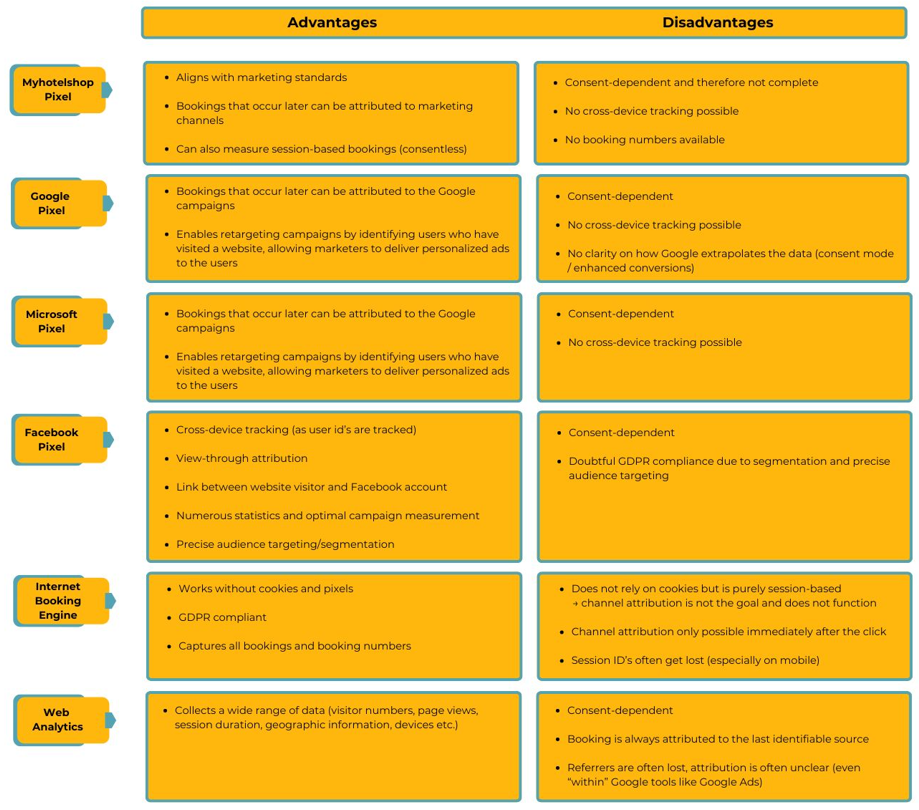Tracking Technologies in the Hospitality Industry

In the world of hospitality, staying ahead of the competition means harnessing the power of data. From driving direct bookings to enhancing the guest experience, tracking technologies have become essential tools for hoteliers looking to optimise every aspect of their business.
In our last post, we explored the crucial role tracking technologies play in the hospitality industry, transforming guesswork into actionable insights. We discussed how tracking helps hotels measure marketing effectiveness, understand customer behaviour, and drive more direct bookings through tools like cookies, session tracking, and fingerprinting.
Now, it’s time to dive even deeper. In this post, we’ll break down specific tracking pixels and web analytics tools, revealing how they work and the unique advantages they offer for optimising your hotel’s marketing strategy. Ready to take your marketing strategy to the next level? Let’s get started!
1. myhotelshop Pixel
The myhotelshop pixel, embedded on the confirmation page of the Internet Booking Engine (IBE), tracks clicks on links and conversions from metasearch campaigns (e.g., Trivago, TripAdvisor, Kayak). It utilises cookie-based tracking with a 30-day window and session-based tracking without requiring consent.
Objective: Demonstrate the performance and profitability of individual marketing campaigns.
Limitations: Challenges with cross-device and cross-channel interactions, and cookie blockers.
2. Google Pixel
Implemented on the website and confirmation page of the IBE, the Google pixel tracks clicks, conversions, and other interactions such as ad calls. Google sets cookies whenever a user clicks on an ad, with a 30-day cookie window. This means that if a conversion occurs within 30 days of the click, it will be attributed to Google. In addition, Google places a cookie when a user views (without clicking or interacting) a display ad or video. The cookie window for this is one day, so any conversion within 24 hours of viewing the ad will be attributed to Google. Google extrapolates data by using Google Consent Mode and Enhanced Conversions. However it is very unclear for the advertiser how exactly Google extrapolates data.
Objective: Measure the performance and profitability of Google campaigns.
Limitations: Similar to the myhotelshop pixel, it faces issues with cross-device interactions and cookie blockers.
3. Microsoft Pixel
Similar to the Google pixel, the Microsoft pixel is used on the website and IBE confirmation page to track clicks and conversions, with a 30-day cookie window.
Objective: Assess the performance and profitability of Microsoft campaigns.
Limitations: Faces the same challenges with cross-device interactions and cookie blockers.
4. Facebook Pixel
This pixel links user behaviour on the website to Facebook profiles, collecting data to track conversions and assist in social media marketing. It uses a unique ID for each ad account. Facebook considers conversions within a specific time frame after a user interacts with an ad. The default attribution window is 7-day click and 1-day view. Facebook can track users across multiple devices to attribute conversions more accurately. Advanced algorithms are used to estimate the likelihood of conversions, especially for view-through attributions. So in general like we see with other big tech players like Google, it is very unclear for the advertiser how exactly data is being extrapolated.
Objective: Evaluate the performance and profitability of social media campaigns, maximising attribution for this channel.
Limitations: Cookie rejecters and blockers can limit tracking effectiveness.
5. Internet Booking Engine (IBE)
The IBE measures bookings, overnight stays, and revenue within a specific timeframe, providing data on booked rates and room types. It uses parameters in the URL to track the source of bookings. However, correct campaign allocation is usually not the main purpose of IBE tracking. It is therefore not suitable for measuring campaign performance standalone.
Objective: Measure marketing revenue and understand the performance of different channels.
Limitations: Bookings made at a later time through different sources without the parameter in the URL cannot be attributed to the original source.
6. Web Analytics (Google Analytics 4 and Matomo)
Web analytics tools like Google Analytics 4 and Matomo analyse website performance, providing insights into user navigation, page views, and traffic sources. They use cookie-based tracking and attribute transactions to the last identifiable source. There are cookieless or server side technologies available to improve data quality. This involves more effort and usually costs. The use must be questioned on a case-by-case basis.
Objective: Analyse user behaviour and flow on a website to optimise performance.
Limitations: Attributions can be skewed if users return through different sources for booking.
A balanced look at the different tracking solution:
Effective tracking of user data and campaign performance is essential for hotels to make informed decisions and refine their marketing strategies. From tracking pixels by myhotelshop, Google, Microsoft, or Facebook to booking engines and web analytics, each technology offers its own strengths and challenges. Choosing the right tool can significantly impact a hotel’s ability to drive long-term success. However, it’s equally important to recognise the limitations of these technologies, particularly in light of evolving privacy regulations and customer expectations.
Currently, each tracking pixel operates independently, with the goal of maximising revenue for its respective channel. This can create challenges when users interact with multiple touchpoints (such as Trivago, Google Ads, or Facebook), as each pixel might attribute the same booking to its channel, leading to overlapping data.
Server-Side Tracking (SST) offers a solution by providing a unified tracking system across all channels. SST not only creates transparency by displaying booking IDs but also prevents duplicate bookings, ensuring more accurate data attribution and reporting.
—
This post originally appeared on the myhotelshop blog here and is reproduced with their permission.
The post Tracking Technologies in the Hospitality Industry appeared first on Hotel Speak.
